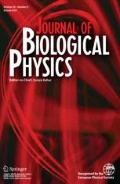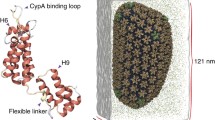Abstract
From the analysis of sizes of approximately 130 small icosahedral viruses we find that there is a typical structural capsid protein, having a mean diameter of 5 nm and a mean thickness of 3 nm, with more than two thirds of the analyzed capsid proteins having thicknesses between 2 nm and 4 nm. To investigate whether, in addition to the fairly conserved geometry, capsid proteins show similarities in the way they interact with one another, we examined the shapes of the capsids in detail. We classified them numerically according to their similarity to sphere and icosahedron and an interpolating set of shapes in between, all of them obtained from the theory of elasticity of shells. In order to make a unique and straightforward connection between an idealized, numerically calculated shape of an elastic shell and a capsid, we devised a special shape fitting procedure, the outcome of which is the idealized elastic shape fitting the capsid best. Using such a procedure we performed statistical analysis of a series of virus shapes and we found similarities between the capsid elastic properties of even very different viruses. As we explain in the paper, there are both structural and functional reasons for the convergence of protein sizes and capsid elastic properties. Our work presents a specific quantitative scheme to estimate relatedness between different proteins based on the details of the (quaternary) shape they form (capsid). As such, it may provide an information complementary to the one obtained from the studies of other types of protein similarity, such as the overall composition of structural elements, topology of the folded protein backbone, and sequence similarity.








Similar content being viewed by others
Notes
This is the basis of the Caspar-Klug classification scheme [14] that classifies different capsid icosahedra in terms of the triangulation number T, which is, roughly, a way to divide the icosahedron in similar, nearly equivalent parts that represent individual proteins.
The triangulation numbers denoted with p (pseudo) do not completely conform to the Caspar-Klug principle of quasi-equivalence since the basic unit is composed of different (but morphologically similar) proteins.
The positions of the amino acids are represented either by the positions of their centers-of-mass (see also [18]), or, where this data was unavailable, by the positions of their C α atoms.
There are 60T proteins in a virus of a given T-number.
The analysis of available space and restricted length of the genome is somewhat different in ssRNA viruses, where the ssRNA molecule is held within the capsid mostly by electrostatic interactions with the capsid proteins. In this case, the quantity of information that can be stored in the capsid scales as \(\overline{R}^2\) [4], so that the production of large proteins always requires the same percentage of the ssRNA information, irrespectively of the radius of the virus.
References
Suttle, C.: Marine viruses – major players in the global ecosystem. Nat. Rev. Microbiol. 5, 801–812 (2007)
Trifonov, E.N.: Definition of life: navigation through uncertainties. Biomol. J. Struct. Dyn. 29, 647–650 (2012)
Roos, W.H., Bruinsma, R., Wuite, G.J.L.: Physical virology. Nat. Phys. 6, 733–743 (2010)
Šiber, A., Lošdorfer Božič, A., Podgornik, R.: Energies and pressures in viruses: contribution of nonspecific electrostatic interactions. Phys. Chem. Chem. Phys. 14, 3746–3765 (2012)
Zandi, R., Reguera, D., Bruinsma, R.F., Gelbart, W.M., Rudnick, J.: Origin of icosahedral symmetry in viruses. Proc. Natl. Acad. Sci. USA 101, 15556–15560 (2004)
Cello, J., Paul, A., Wimmer, E.: Chemical synthesis of poliovirus cDNA: Generation of infectious virus in the absence of natural template. Science 97, 1016–1018 (2002)
Koonin, E.V., Martin, W.: On the origin of genomes and cells within inorganic compartments. Trends Genet. 647–654, 021910 (2005)
Pearson, H.: Virophage suggests viruses are alive. Nature 454, 677 (2008)
Suzan-Monti, M., La Scola, B., Raoult, D.: Genomic and evolutionary aspects of mimivirus. Virus Res. 117, 135–155 (2006)
Claverie, J.M., Abergel, C.: Mimivirus: the emerging paradox of quasi-autonomous viruses. Trends Genet. 26, 431–437 (2010)
Arslan, D., Legendre, M., Seltzer, V., Abergel, C., Claverie, J.M.: Distant mimivirus relative with a larger genome highlights the fundamental features of megaviridae. Proc. Natl. Acad. Sci. USA 108, 17486 (2011). doi:10.1073/pnas.1110889108
Holmes, E.C.: The Evolution and Emergence of RNA Viruses. Oxford University Press (2009)
Koonin, E.V., Mushegian, A.R., Dolja, V.V.: Computer analysis of amino acid sequences. In: Foster, G.D., Taylor, S.C., Walker, J.M. (eds.) Plant Virology Protocols, vol. 81 of Methods in Molecular Biology, pp. 319–337, Humana Press (1998)
Caspar, D.L.D., Klug, A.: Physical principles in the construction of regular viruses. Cold Spring Harbor Symp. 27, 1–24 (1962)
Lidmar, J., Mirny, L., Nelson, D.R.: Virus shapes and buckling transitions in spherical shells. Phys. Rev. E68, 051910 (2003)
Carrillo-Tripp, M., Shepherd, C.M., Borelli, I.A., Venkataraman, S., Lander, G., Natarajan, P., Johnson, J.E., Brooks III, C.L., Reddy, V.S.: Viperdb2: an enhanced and web api enabled relational database for structural virology. Nucleic Acids Res. 37, D436–D442 (2009)
Konevtsova, O.V., Rochal, S.B., Lorman, V.L.: Chiral quasicrystalline order and dodecahedral geometry in exceptional families of viruses. Phys. Rev. Lett. 108, 038102 (2012)
Lošdorfer Božič, A., Šiber, A., Podgornik, R.: How simple can a model of an empty viral capsid be? charge distributions in viral capsids. J. Biol. Phys. 38, 657–671 (2012)
Šiber, A.: Buckling transition in icosahedral shells subjected to volume conservation constraint and pressure: Relations to virus maturation. Phys. Rev. E E73, 061915 (2006)
Rossmann, M.G., Erickson, J.W.: Structure and assembly of icosahedral shells. In: Casjens, S. (ed.) Virus Structure and Assembly. Jones and Bartless Publishers (1985)
Ting, C.L., Wu, J., Wang, Z.G.: Thermodynamic basis for the genome to capsid charge relationship in electrostatically-driven viral encapsidation. Proc. Natl. Acad. Sci. USA 108, 16986–16991 (2011)
Griep, S., Hobohm, U.: PDBselect 1992–2009 and PDBfilter-select. Nucleic Acids Res. 38, D318–D319 (2010)
Aznar, M., Luque, A., Reguera, D.: Relevance of capsid structure in the buckling and maturation of spherical viruses. Phys. Biol. 9, 036003 (2012)
Kivela, H.M., Kalkkinen, N., Bamford, D.H.: Bacteriophage PM2 has a protein capsid surrounding a spherical proteinaceous lipid core. Virology J. 76, 8169–8178 (2002)
Benson, S.D., Bamford, J.K.H., Bamford, D.H., Burnett, R.M.: Viral evolution revealed by bacteriophage PRD1 and human adenovirus coat protein structures. Cell 98, 825–833 (1999)
Mannige, R.V., Brooks III, C.L..: Periodic table of virus capsids: implications for natural selection and design. PLoS ONE 5, e9423 (2010)
May, E.R., Brooks III, C.: On the morphology of viral capsids: Elastic properties and buckling transitions. Phys. J. Chem. B116, 8604–8609 (2012)
Morgan, G.J.: Historical review: viruses, crystals and geodesic domes. Trends Biochem. Sci. 28, 86–90 (2003)
Catalano, C.E.: In: Catalano, C.E. (ed.) Viral Genome Packaging Machines: Genetics, Structure, and Mechanism, pp. 1–4. Landes Bioscience, Georgetown, TX (2005)
Gelbart, W.M., Knobler, C.M.: The physics of phages. Phys. Today 61, 42–47 (2008)
Acknowledgements
We thank Alberto Vianelli for informing us about [20]. We also thank the two anonymous reviewers for their suggestions on improving the manuscript. A.L.B. acknowledges the support from the Slovene Agency for Research and Development under the young researcher grant. A.Š. acknowledges support from the Ministry of Science, Education, and Sports of Republic of Croatia (Grant No. 035-0352828-2837). R.P. acknowledges the support from the Slovene Agency for Research and Development (Grant No. P1-0055 and J1-4297).
Author information
Authors and Affiliations
Corresponding author
Rights and permissions
About this article
Cite this article
Lošdorfer Božič, A., Šiber, A. & Podgornik, R. Statistical analysis of sizes and shapes of virus capsids and their resulting elastic properties. J Biol Phys 39, 215–228 (2013). https://doi.org/10.1007/s10867-013-9302-3
Received:
Accepted:
Published:
Issue Date:
DOI: https://doi.org/10.1007/s10867-013-9302-3




